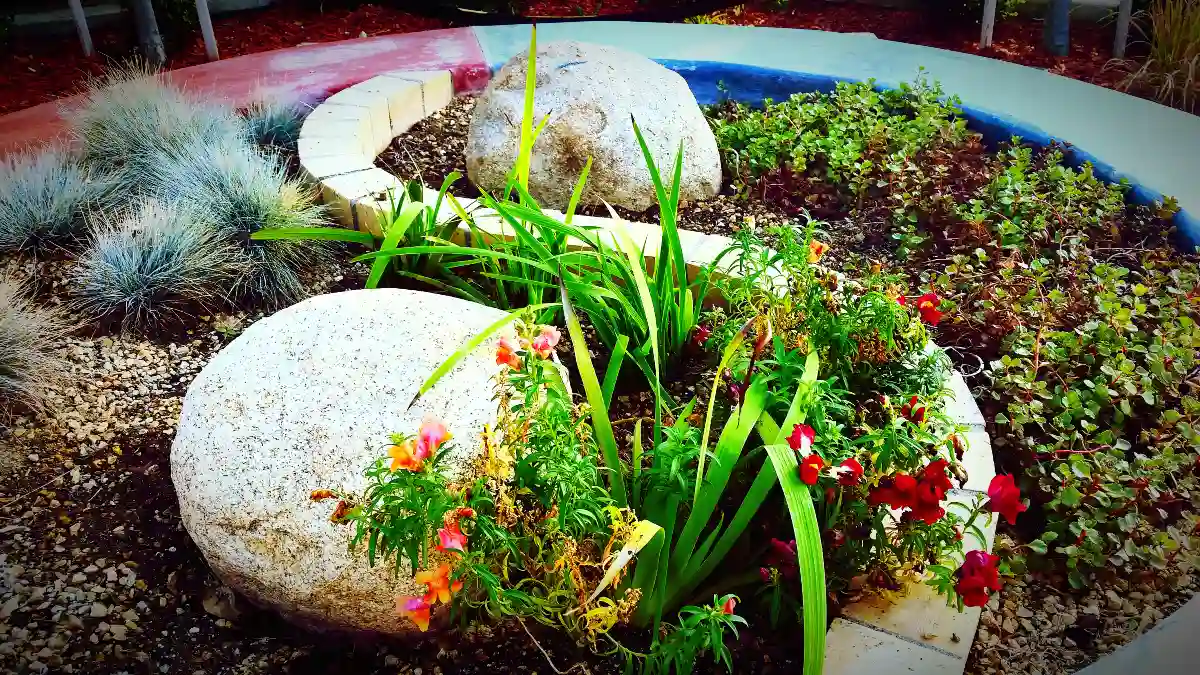Watering bans and heat waves don’t have to kill your garden — with the right choices, drought-tolerant landscapes can look lush and use a fraction of the water. In 2025, outdoor irrigation is still one of the biggest household water expenses, and the U.S.
Environmental Protection Agency notes that residential outdoor use approaches 8 billion gallons per day, with as much as 50% lost to overwatering and inefficient systems. That’s water — and money — literally running down the curb.
This guide gives you 12 drought-tolerant landscaping ideas you can apply right away: map hydrozones and set a water budget, swap thirsty turf for region-appropriate groundcovers, install drip/micro-irrigation and smart controllers, use mulch and permeable hardscape, capture rain, build healthier soils, and more.
Each idea includes “why it works,” exact steps, and plant/tool suggestions — all backed by recent extension and WaterSense guidance. Put a few together and you can cut outdoor use dramatically; Oregon State University Extension reports that coordinated water-wise design and maintenance can trim landscape water use by 35–75%.
By the end, you’ll have a practical, climate-ready plan for a low-water garden, packed with drought-resistant plants and real-world xeriscape ideas that stay beautiful when the forecast doesn’t.
Map Hydrozones + Set a Water Budget
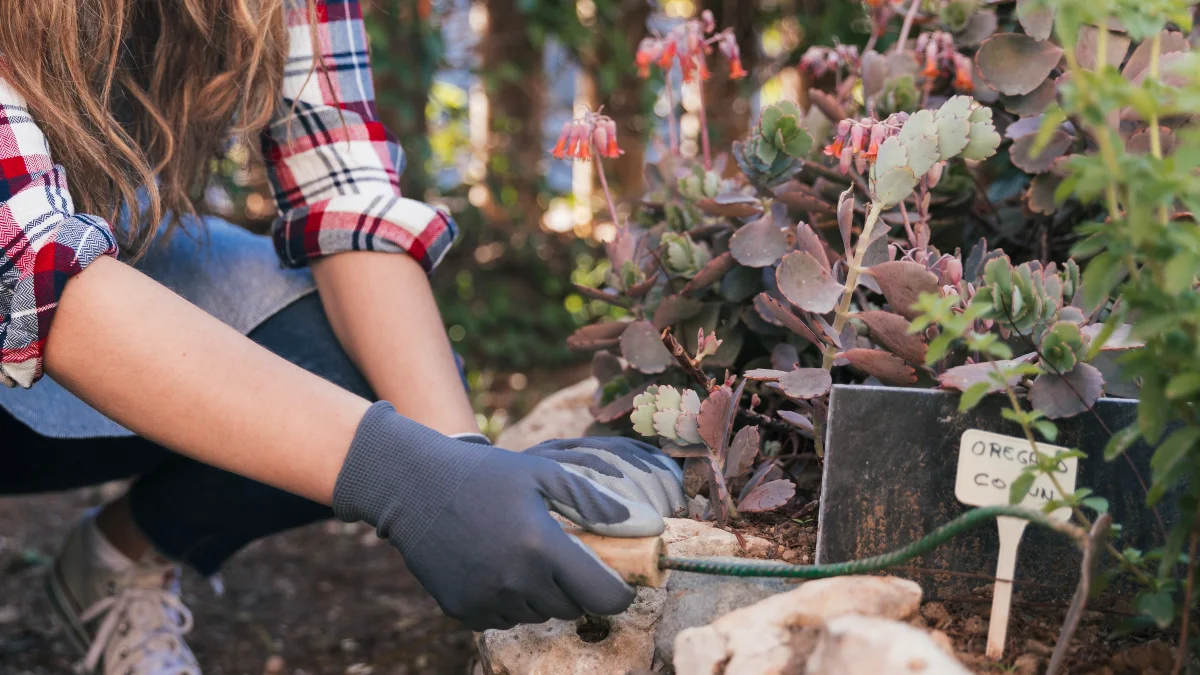
Hydrozones + Water Budget: The Fast-Track Method
Use zones, climate data, and a simple allowance to prevent overwatering before it starts.
3 Steps to Get Your Number
Sketch hydrozones (High / Moderate / Low). Keep them discrete with paths/edging so “low” beds never receive “high” irrigation (OSU Extension).
Find climate inputs with EPA WaterSense Data Finder: grab peak-month ETo (evapotranspiration) and typical rainfall for your ZIP.
Run the Water Budget Tool to compare your planned Landscape Water Requirement (LWR) vs. the Allowance. If over budget, shift plants/areas or improve irrigation efficiency.
Mini Water Budget (Example)
WUCOLS: KL = ks (species) × kd (density) × km (microclimate)
Peak ETo = 6 in; KL = 0.30 (low-water bed); Area = 1,200 sq ft; IE (drip) = 0.80
LWR ≈ 6 × 0.30 × 1,200 × 0.623 ÷ 0.80 ≈ ~1,680 gallons/month
Tip: Start with kd and km near 1.0 (average), then nudge up for dense plantings or hot, reflective sites; down for open, shaded areas (WUCOLS/WaterSense approach).
Hydrozone Cheat Sheet
Deep, infrequent irrigation after establishment
Targeted drip; adjust by season
Keep isolated; consider rain capture
Permeable Hardscape Picks (Don’t Block Your Budget)
- Open-joint pavers over a compacted, free-draining base — routes rainfall into soil rather than the street (OSU Extension).
- Decomposed granite or gravel paths with shallow grade toward planting swales.
- Stepping stones in mulch — keeps zones separate and soil pervious.
Guidance synthesized from Oregon State University Extension, US EPA WaterSense, and WUCOLS methodology for landscape water use.
Start with a quick sketch of your yard and group plants by water needs: high, moderate, and low/very low. Keep these hydrozones physically separate with paths, edging, or grade breaks so a “low” bed doesn’t get “high” water by mistake.
Oregon State University Extension emphasizes this step, along with choosing permeable hardscape and grading to direct rainfall into beds or a rain garden rather than toward the street. These simple layout moves are foundational to any set of drought-tolerant landscaping ideas.
Next, set a water budget so you know your allowance before you plant. Use the EPA WaterSense Water Budget Tool and the Data Finder to pull your ZIP code’s peak-month evapotranspiration (ET) and typical rainfall. The tool compares your planned landscape water requirement to an allowance based on reference ET; if you’re over, adjust plant choices, bed sizes, or irrigation method until you’re under budget. This gives you an objective target — and a clear reason to prioritize low-water zones.
Put it together: hydrozone the plan, route rainfall into planting areas, and design irrigation by zone. Follow-through matters: OSU Extension finds that when these practices are applied together, landscapes often use 35–75% less water.
Replace Thirsty Lawn with Low-Water Alternatives
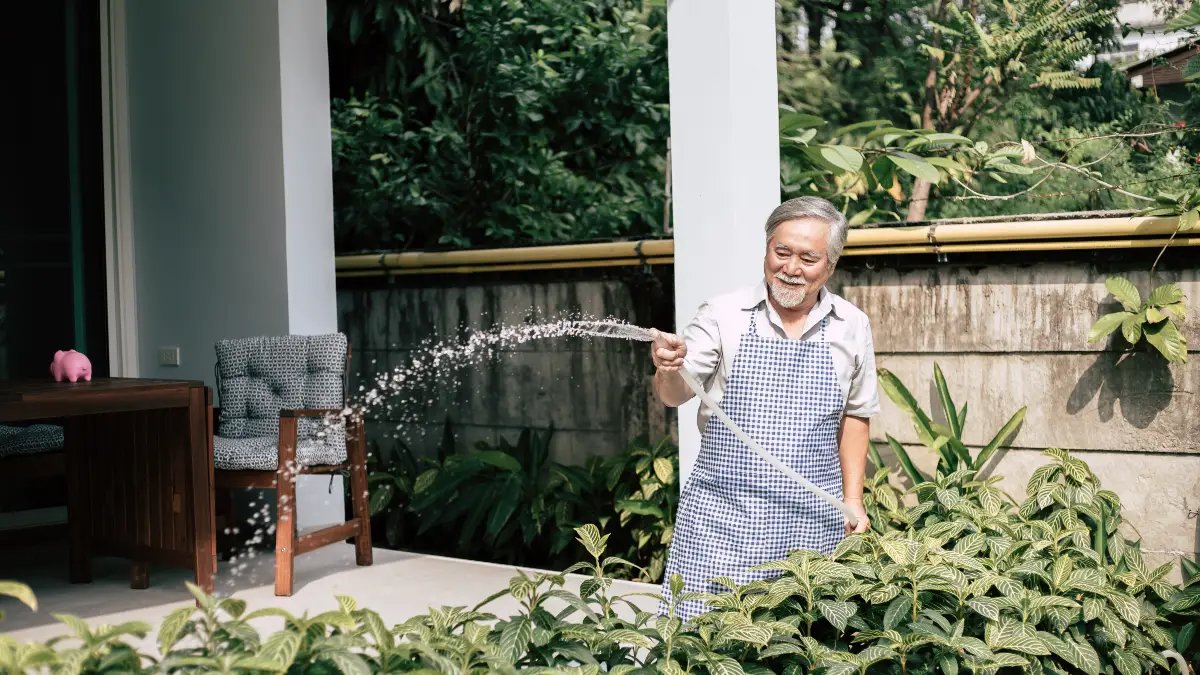
Start where turf does the least for you — curb strips, side yards, steep slopes, or under trees — and convert those first. In warm climates, UF/IFAS Extension highlights durable, mow-light groundcovers like perennial peanut (Arachis glabrata), sunshine mimosa (Mimosa strigillosa), and frogfruit (Phyla nodiflora); these spread into a cohesive, nectar-rich mat with far less irrigation than conventional turf. In temperate regions, University of Maryland Extension points to native sedges (Carex spp.) and moss phlox (Phlox subulata) as attractive, low-input “lawn” patches along paths and sunny slopes.
Expect meaningful savings. University of Arizona Cooperative Extension reports that turf-to-xeriscape conversions can reduce outdoor water use by around 50%, with even larger cuts where overseeded or high-input lawns are replaced. Many cities make this easier: Los Angeles Department of Water and Power promotes a residential turf-replacement rebate (commonly $5 per square foot in 2025), and higher incentives exist for commercial/public projects. Always secure pre-approval before you remove grass.
Action steps: kill or smother turf (sheet-mulch works), retrofit irrigation to drip for new beds, plant in 12–18-inch spacing blocks, and top with 3–4 inches of mulch to speed establishment and suppress weeds. That’s how you turn lawn alternatives into lasting xeriscape ideas filled with drought-resistant plants.
Switch to Drip/Micro-Irrigation Where Possible

If water hits leaves, fences, or pavement, you’re losing it. Drip and microsprays deliver slow, precise doses at the root zone and routinely hit ~80–85% application efficiency when designed and maintained well, according to UC Davis (R. L. Snyder). That’s a big jump over typical overhead sprinklers in real-world yards.
Design the retrofit by zone. For shrub and perennial beds in a low-water garden, run 1/2-inch poly laterals with 1/4-inch branches to 0.5–1 gph emitters at each plant (or a 12–18-inch grid of inline emitters for evenly spaced plantings). In turf removal areas, consider subsurface drip; the University of Arizona Cooperative Extension summarizes research showing SDI often reduces weed biomass versus furrow or sprinkler irrigation while maintaining yields — the same principle helps ornamental beds stay cleaner.
Maintenance makes or breaks drip. Clemson University’s Land-Grant Press and UF/IFAS recommend a filter matched to your water quality, pressure regulation, seasonal flushing of lines, and periodic acid/chlorination where minerals or biofilm are an issue. Keep a spare bag of emitters and end-caps on hand; clogs happen. Add a basic conversion kit/manifold to repurpose your old sprinkler valve — it’s a one-afternoon upgrade with outsized savings.
Add a WaterSense Smart Controller

Replace the old clock with a smart irrigation controller that waters by weather or by what your soil actually needs. EPA WaterSense notes that weather-based and soil moisture sensor controllers prevent irrigation on cool, rainy, or already-moist days — the biggest source of waste in typical yards.
Upgrading from a basic timer can save up to 15,000 gallons per home per year, and EPA estimates that about 50% of outdoor water is lost to wind, evaporation, and runoff from inefficient schedules. Program by hydrozone, set plant types/soil/slope correctly, enable seasonal adjustment, and lock in a monthly “maximum minutes” to avoid drift.
If Wi-Fi is spotty, add a rain/freeze sensor as a fail-safe. Check for local rebates and look for the WaterSense label on packaging. For the most precise control, pair a weather-based controller with a buried soil moisture sensor in your thirstiest zone, then copy its logic to the others once you’ve verified it works.
Mulch Right to Lock In Soil Moisture
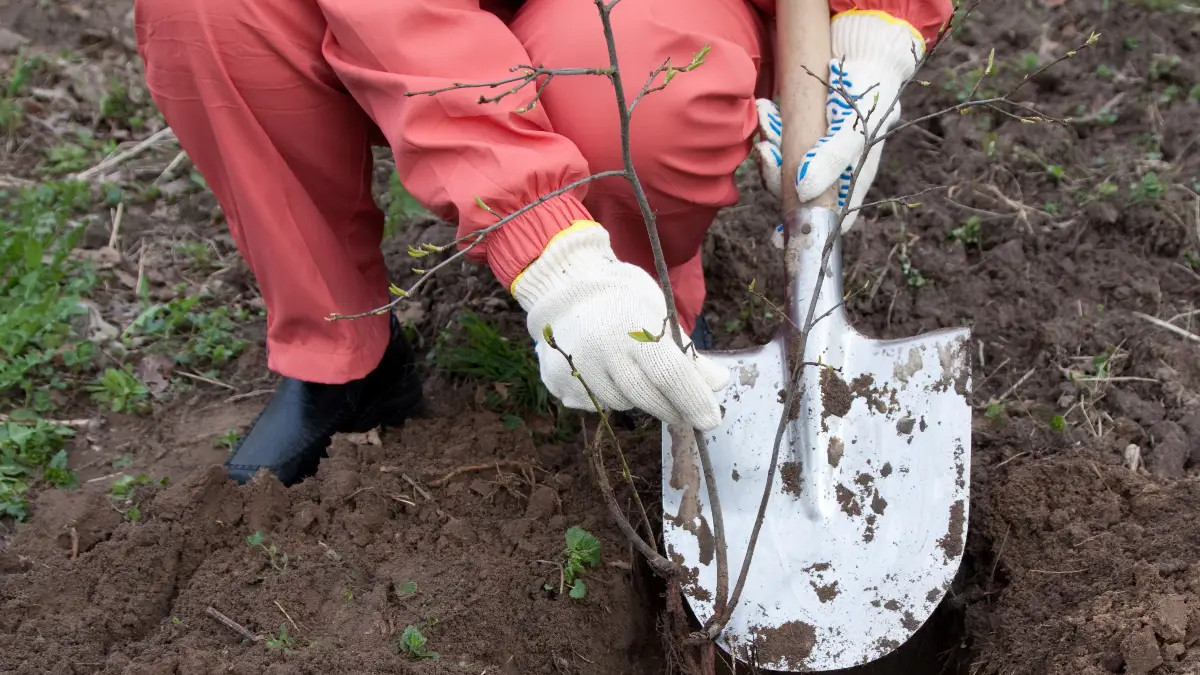
Think of mulch as moisture insurance. In planting beds, apply 3–5 inches of organic mulch (shredded bark, arborist wood chips, or leaf mold) and keep a mulch-free collar around trunks to prevent rot.
Oregon State University Extension reports that a 3–5-inch layer can reduce soil-water evaporation by about 70% compared with bare soil — which often translates to one to two extra days between irrigations in hot spells.
Refresh yearly where it decomposes quickly, and rake to break up crusting so water can pass through. For gravel or rock around succulents or in a xeriscape, aim for 2–3 inches over a compacted, free-draining base; for wood chips and bark, 3–4 inches is ideal, says Utah State University Extension.
Pro tip: weigh bags at the store or calculate yardage before delivery — a 2-inch layer takes roughly 6 cubic yards per 1,000 sq ft. Track one mulched bed versus an unmulched bed for a month; you’ll usually see fewer weeds, cooler soil, and shorter.
Build a Gravel/Rock Garden with Permeable Paths
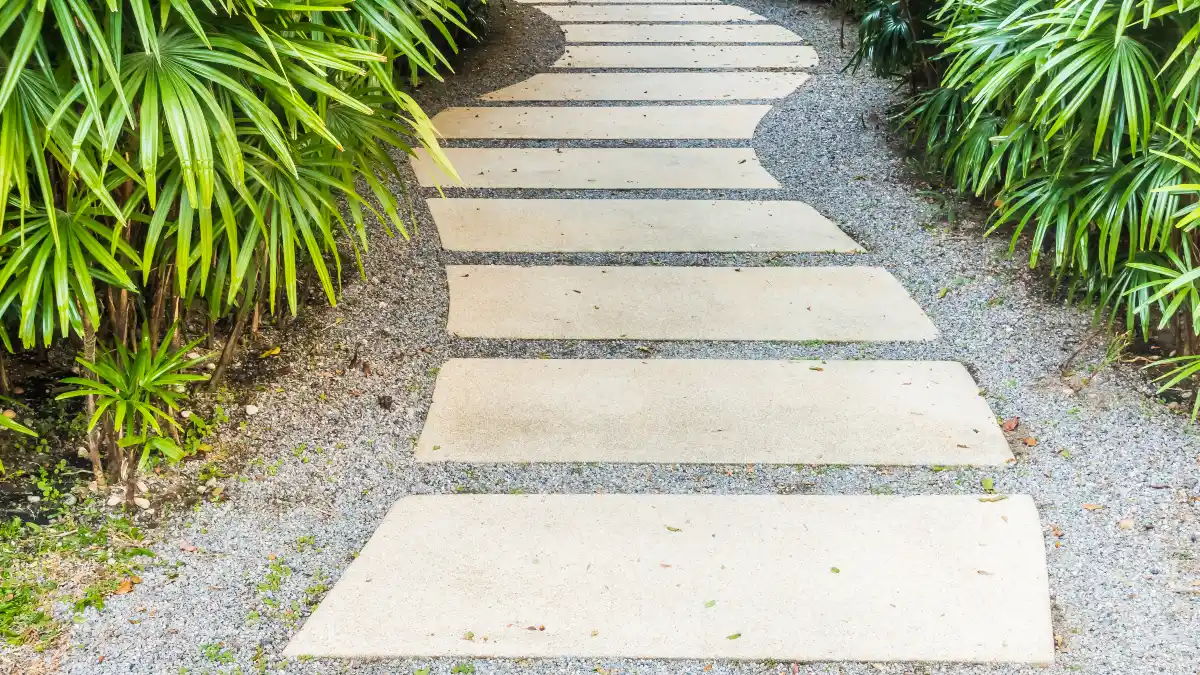
Trade thirsty borders and slick concrete for a gravel garden with permeable hardscape that soaks up stormwater. OSU Extension recommends permeable pavers, decomposed granite, or open-joint flagstone over a compacted base so rainfall can infiltrate rather than run off. Keep geotextile use minimal (only where you must control aggressive weeds) to maintain infiltration, and contain edges with steel, stone, or brick.
Space plants wider than in conventional beds to reduce competition for scarce moisture, then spot-water with drip. For structure and color, mix drought-resilient accents such as agaves, aloes, and yarrows; pull choices from UC Davis Arboretum All-Stars and Plant Select to ensure real-world performance in heat and drought. Start with a 3–4″ excavation, lay and compact a 3–4″ drainage base, top with 2–3″ decorative gravel, cut planting pockets with amended soil, and run a drip line just under the surface.
This is classic xeriscape design: less water, clean lines, and year-round texture. (OSU permeable guidance; UC Davis and Plant Select plant databases.)
Plant Native & Climate-Ready
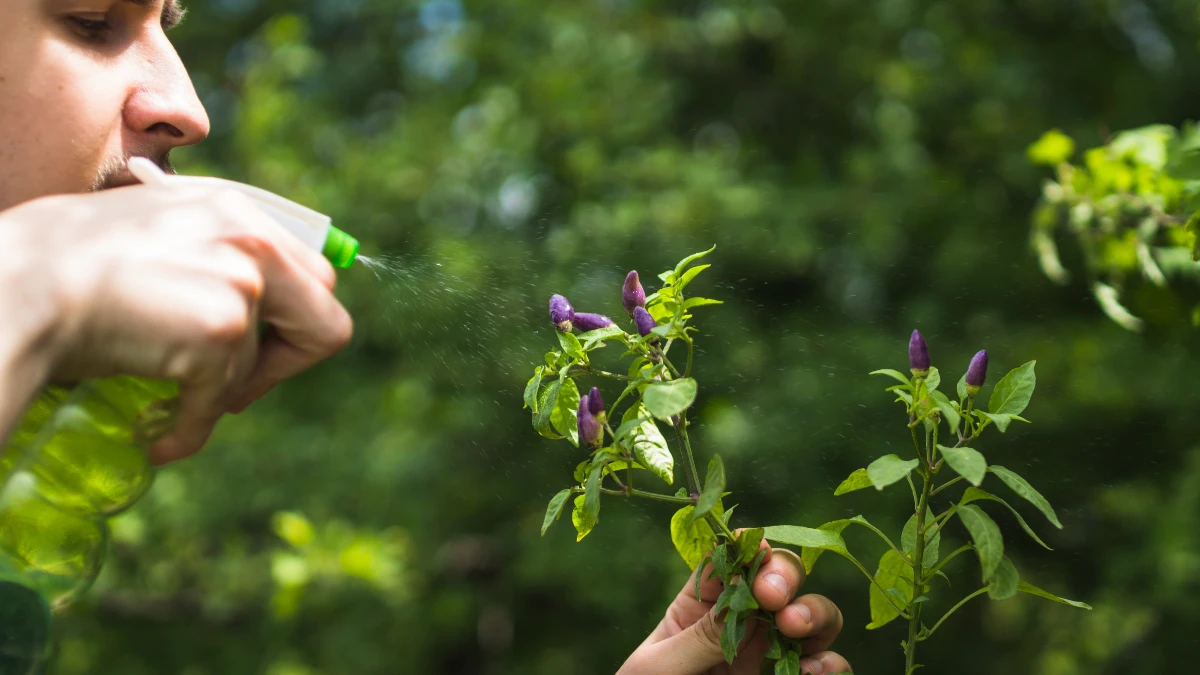
Choose plants that are proven to thrive with less. The UC Davis Arboretum All-Stars program — freshly updated in 2025 — highlights climate-ready shrubs, perennials, and grasses tested in hot, dry conditions; the roster now spans about 130 selections with strong habitat value. In the Intermountain West, Plant Select curates region-tested, water-wise plants.
Before you buy, confirm your picks in WUCOLS (Water Use Classification of Landscape Species), which in 2025 added thousands of taxa and city/region filters so you can target very low or low water-use ratings for your area. Build layers for structure and pollinators:
Deergrass (Muhlenbergia rigens): bold clumps; very low water once established (UC Davis All-Star).
Cleveland sage (Salvia clevelandii selections): fragrant, hummingbird-magnet shrub; low water (All-Star).
Red yucca (Hesperaloe parviflora): spiky form, summer bloom spikes; xeric (Plant Select).
Lavender (Lavandula spp.) or yarrow (Achillea spp.): long bloom, pollinator value; low water.
Mix three textures (shrub, grass, perennial), keep mature widths in mind, and group by hydrozone so irrigation stays honest. (UC Davis Arboretum All-Stars update; Plant Select; WUCOLS 2025 database.)
Shade Strategically with Trees, Arbors & Vines
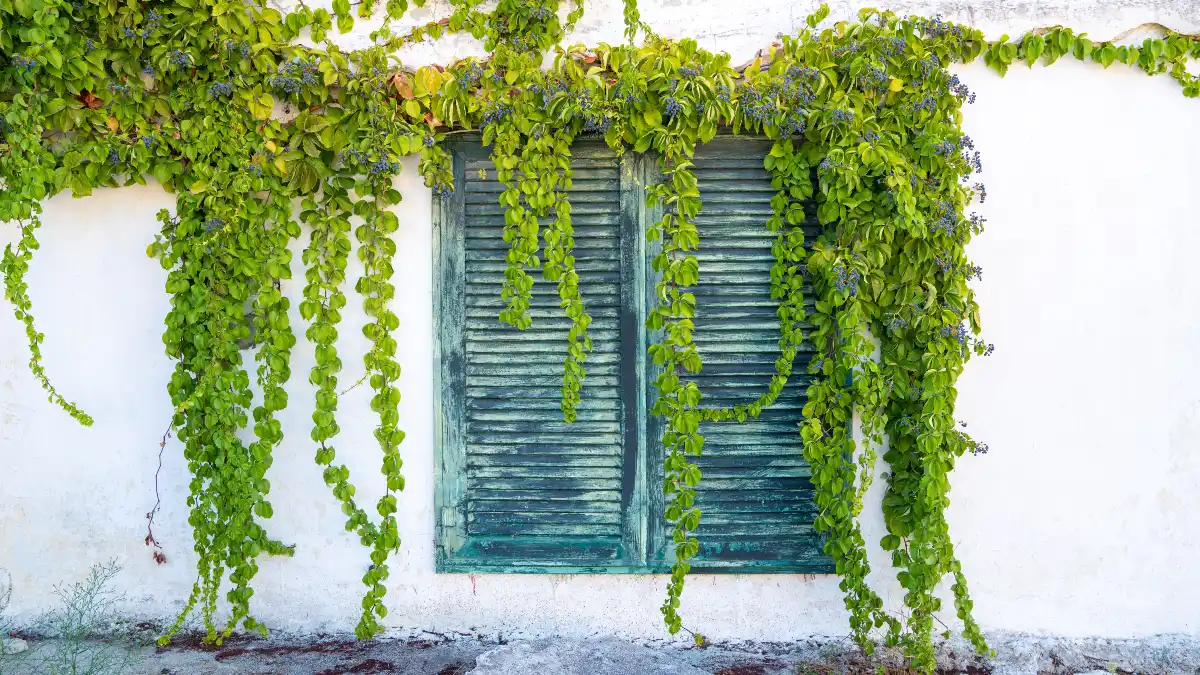
Beat heat at the source: create a microclimate that lowers leaf temperatures and soil evaporation. The US EPA highlights trees and vegetation as core tools for reducing heat-island effects because they shade surfaces, block solar gain, and cool air via transpiration. Prioritize drought-tolerant shade trees on the west and south sides to protect afternoon exposures, then add a simple pergola with a vine to cast moving shade on beds and patios.
Choose species that establish on modest irrigation (after the first 1–2 seasons) and won’t crowd rooflines. Train vines on open trellises so breezes can pass, and keep posts/footings clear of swales so you don’t compromise drainage or rain-capture features.
Extend organic mulch under the canopy to reduce evaporation and keep roots cool. This combination lowers plant stress, slows moisture loss, and can materially cool hardscape in heat waves, in line with EPA guidance on trees/vegetation for site cooling.
Capture Rain: Barrels, Cisterns & Dry Creek Beds
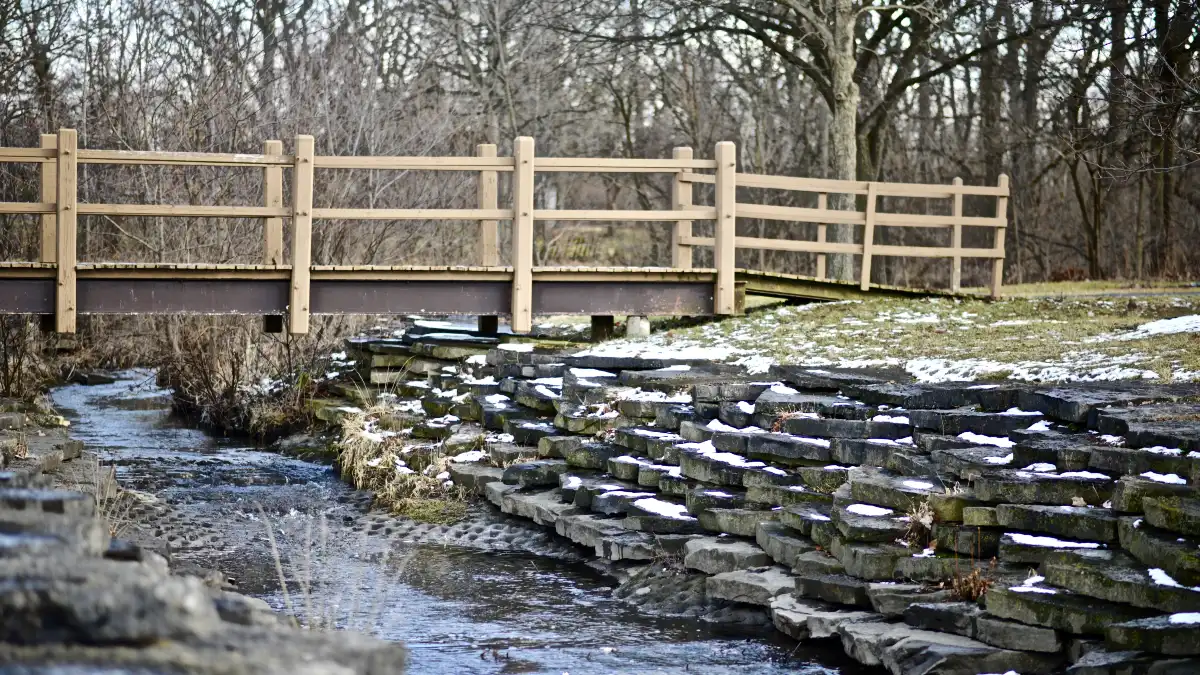
Store free water first. Size your barrel or cistern to the roof: gallons = roof area (sq ft) × rainfall (in) × 0.623. Fit downspouts with leaf screens and first-flush diverters; check local codes. Use stored water for hand-watering high-value beds and new plantings. In the landscape, carve a shallow dry creek bed or swale to slow, spread, and sink stormwater into planted hydrozones rather than the street.
Keep the bed’s high side (berm) planted with deep-rooted, drought-tolerant species and line only where necessary so infiltration remains high. For day-to-day efficiency, pair rain capture with drip or soaker delivery; OSU Extension notes these systems typically operate at 85–90% efficiency, stretching each stored gallon farther than overhead sprinklers.
The result is a resilient, low-water garden that weathers dry spells and makes the most of every storm.
Boost Soil’s Water-Holding with Compost
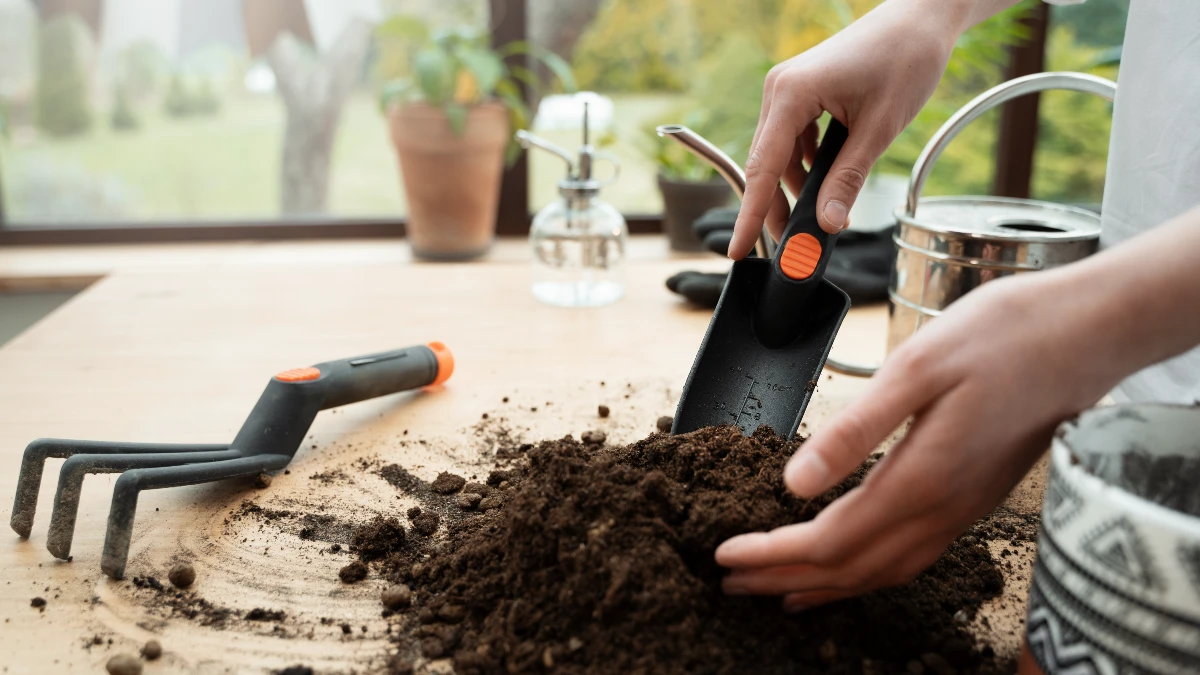
Healthy soil acts like a sponge. Before planting, blend 2–4 inches of compost into new beds; on established beds, top-dress 1 inch annually and cover with mulch. Over time this raises soil organic matter (SOM), improving structure, infiltration, and water storage.
UF/IFAS and USDA-NRCS summarize a practical rule of thumb: each +1% SOM can help soil hold ~20,000 gallons more water per acre. For homeowners, that’s roughly ~460 gallons per 1,000 sq ft (and ~90 gallons for a 200-sq-ft bed) — enough to skip irrigations during heat spells.
Avoid heavy, fast-release fertilization; OSU Extension cautions it stimulates lush growth that drinks more water and increases salt stress in dry periods. Compost plus mulch lengthens the interval between waterings and helps plants root deeper — the essence of drought-proof soil.
Design with Containers the Water-Wise Way
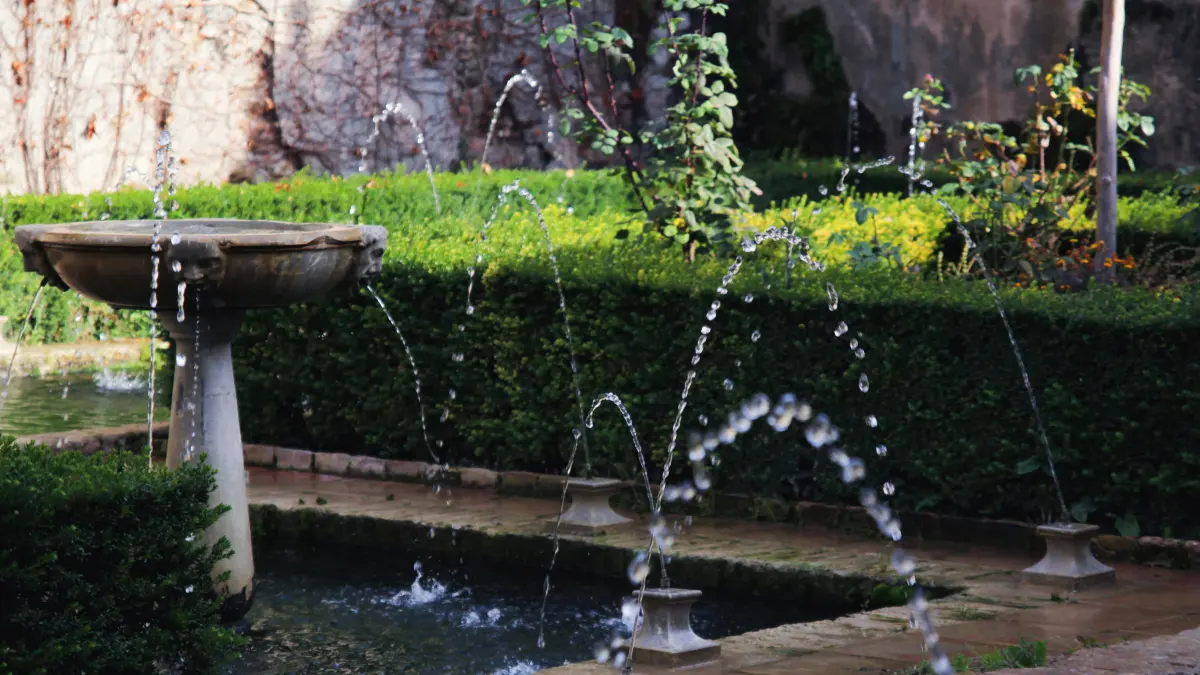
Treat pots like micro hydrozones. Group containers by sun and wind exposure; use taller plants to shade smaller pots and reduce surface evaporation. Favor deep containers and quality mixes with composted bark for water retention, then mulch the surface (fine gravel or bark) to slow drying.
Automate watering with a simple drip to pots setup: run 1/2-inch poly along the group, tee 1/4-inch lines to each pot, and use 0.5–1 gph button emitters or small drip rings. Set longer, less frequent cycles to wet the full root zone; adjust by pot size and exposure.
These choices mirror drip principles from UC Davis irrigation guidance and yield steadier moisture with minimal waste — perfect for a container garden in drought.
Maintain for Savings: Audits, Mulch Refresh, Mow High

Set a five-minute weekly audit during the watering season. Turn zones on, fix tilted or clogged nozzles, and check for leaks and overspray. OSU Extension notes households with automatic irrigation often use up to 2× more water than those who manually water — convenience can hide waste, so monitoring matters.
Refresh mulch to 3–5 inches in beds each year to lock in moisture and suppress weeds, and keep a mulch-free collar around trunks. If you keep some turf, mow high (upper end of the recommended range), water deeply but infrequently, and let nonessential areas go dormant in severe droughts.
Ask your utility about free irrigation audits or smart-controller rebates; a 30-minute check can translate into real savings on the next bill.
Conclusion
The most water-smart yards aren’t built on one magic fix — they combine simple moves that add up. You started by mapping hydrozones and setting a water budget, then swapped turf for resilient plantings, converted to drip and a smart controller, and locked in moisture with mulch.
You shaped a gravel garden, chose climate-ready plants, added strategic shade, captured rain, upgraded soil with compost, streamlined containers, and set a quick maintenance routine. Put two or three of these into action this month, then build from there.
For fine-tuning, use WaterSense tools to dial irrigation and WUCOLS to pick truly drought-resistant plants for your region. With a clear plan and a few weekend projects, these drought-tolerant landscaping ideas help you save water and still love your garden.

